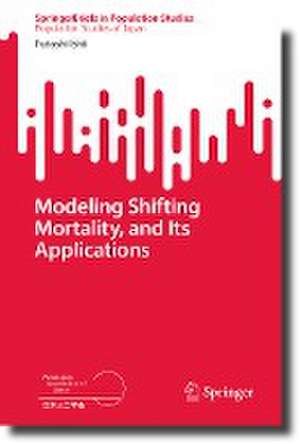Modeling Shifting Mortality, and Its Applications: SpringerBriefs in Population Studies
Autor Futoshi Ishiien Limba Engleză Paperback – aug 2023
Din seria SpringerBriefs in Population Studies
-
 Preț: 177.49 lei
Preț: 177.49 lei -
 Preț: 355.54 lei
Preț: 355.54 lei -
 Preț: 317.11 lei
Preț: 317.11 lei -
 Preț: 442.62 lei
Preț: 442.62 lei - 15%
 Preț: 463.03 lei
Preț: 463.03 lei - 15%
 Preț: 463.68 lei
Preț: 463.68 lei -
 Preț: 377.57 lei
Preț: 377.57 lei -
 Preț: 414.42 lei
Preț: 414.42 lei -
 Preț: 476.57 lei
Preț: 476.57 lei -
 Preț: 376.80 lei
Preț: 376.80 lei -
 Preț: 376.22 lei
Preț: 376.22 lei -
 Preț: 377.73 lei
Preț: 377.73 lei -
 Preț: 477.17 lei
Preț: 477.17 lei -
 Preț: 379.09 lei
Preț: 379.09 lei -
 Preț: 346.66 lei
Preț: 346.66 lei -
 Preț: 380.07 lei
Preț: 380.07 lei -
 Preț: 343.88 lei
Preț: 343.88 lei -
 Preț: 374.46 lei
Preț: 374.46 lei -
 Preț: 343.39 lei
Preț: 343.39 lei -
 Preț: 205.29 lei
Preț: 205.29 lei -
 Preț: 378.92 lei
Preț: 378.92 lei -
 Preț: 375.23 lei
Preț: 375.23 lei -
 Preț: 378.34 lei
Preț: 378.34 lei -
 Preț: 474.84 lei
Preț: 474.84 lei -
 Preț: 476.42 lei
Preț: 476.42 lei -
 Preț: 379.09 lei
Preț: 379.09 lei -
 Preț: 476.79 lei
Preț: 476.79 lei -
 Preț: 441.85 lei
Preț: 441.85 lei - 15%
 Preț: 461.73 lei
Preț: 461.73 lei -
 Preț: 375.23 lei
Preț: 375.23 lei -
 Preț: 259.96 lei
Preț: 259.96 lei -
 Preț: 343.88 lei
Preț: 343.88 lei -
 Preț: 442.62 lei
Preț: 442.62 lei -
 Preț: 474.67 lei
Preț: 474.67 lei -
 Preț: 443.75 lei
Preț: 443.75 lei -
 Preț: 443.00 lei
Preț: 443.00 lei -
 Preț: 262.09 lei
Preț: 262.09 lei -
 Preț: 376.80 lei
Preț: 376.80 lei -
 Preț: 377.18 lei
Preț: 377.18 lei -
 Preț: 311.91 lei
Preț: 311.91 lei -
 Preț: 376.59 lei
Preț: 376.59 lei -
 Preț: 174.62 lei
Preț: 174.62 lei -
 Preț: 379.09 lei
Preț: 379.09 lei -
 Preț: 477.72 lei
Preț: 477.72 lei -
 Preț: 340.45 lei
Preț: 340.45 lei -
 Preț: 374.85 lei
Preț: 374.85 lei -
 Preț: 475.22 lei
Preț: 475.22 lei
Preț: 344.90 lei
Nou
Puncte Express: 517
Preț estimativ în valută:
66.01€ • 68.66$ • 54.49£
66.01€ • 68.66$ • 54.49£
Carte disponibilă
Livrare economică 24 martie-07 aprilie
Preluare comenzi: 021 569.72.76
Specificații
ISBN-13: 9789819925087
ISBN-10: 9819925088
Pagini: 79
Ilustrații: XIII, 79 p. 47 illus., 18 illus. in color.
Dimensiuni: 155 x 235 mm
Greutate: 0.18 kg
Ediția:1st ed. 2023
Editura: Springer Nature Singapore
Colecția Springer
Seriile SpringerBriefs in Population Studies, Population Studies of Japan
Locul publicării:Singapore, Singapore
ISBN-10: 9819925088
Pagini: 79
Ilustrații: XIII, 79 p. 47 illus., 18 illus. in color.
Dimensiuni: 155 x 235 mm
Greutate: 0.18 kg
Ediția:1st ed. 2023
Editura: Springer Nature Singapore
Colecția Springer
Seriile SpringerBriefs in Population Studies, Population Studies of Japan
Locul publicării:Singapore, Singapore
Cuprins
Introduction.- Mortality Trends and Projection Models in Japan.- Data and Methods.- Linear Difference Model.- Tangent Vector Field Approach to Mortality Projection.- Application to Analysis of the Trends of Modal Age at Death.- Summary and Conclusion.
Notă biografică
Dr. Futoshi Ishii is a professor of Keio University, Tokyo, Japan. He received his Ph.D. in demography from University of California, Berkeley, in 2014. He is a formal demographer who has contributed to the official population projections for Japan when he worked at the National Institute of Population and Social Security Research (IPSS). He is a founding director of the Japanese Mortality Database at IPSS, which is a database of Japanese life tables frequently used in mortality studies for Japan.
His major research fields are population projection, mortality analysis, and mathematical demography. He has published many books and papers in these fields that include co-edited book “Choju Kenko no Jinkogaku (Demography of Longevity and Health)”(Hara Shobo 2021).
His major research fields are population projection, mortality analysis, and mathematical demography. He has published many books and papers in these fields that include co-edited book “Choju Kenko no Jinkogaku (Demography of Longevity and Health)”(Hara Shobo 2021).
Textul de pe ultima copertă
This book describes a novel method for mortality modeling applying the shifting feature of the mortality curve. In Japan, the increase and pace of the extension in life expectancy have been quite remarkable. Therefore, existing mortality models often cannot capture the peculiarities of Japanese mortality, nor can the Lee–Carter model, which is now regarded internationally as a standard model. One of the important concepts to model recent Japanese mortality is a shifting feature. In this book, the linear difference model, which has many advantages for modeling and analyzing Japanese mortality, is introduced. The book shows applications of the model to mortality projection with a tangent vector field approach and decomposition of the change of modal age at death. The models introduced here are useful tools for modeling mortality with strong shifting features, as in Japan.
Caracteristici
Introduces a novel method for mortality modeling applying the shifting feature of the mortality curve Describes useful ideas for modeling the shifting mortality that are not examined in other books Details a method for mortality projection and decomposition of modal age at death by applying the models
